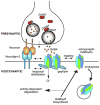GABA and neuroligin signaling: linking synaptic activity and adhesion in inhibitory synapse development
- PMID: 18513949
- PMCID: PMC3988756
- DOI: 10.1016/j.conb.2008.05.008
GABA and neuroligin signaling: linking synaptic activity and adhesion in inhibitory synapse development
Abstract
GABA-mediated synaptic inhibition is crucial in neural circuit operations. In mammalian brains, the development of inhibitory synapses and innervation patterns is often a prolonged postnatal process, regulated by neural activity. Emerging evidence indicates that gamma-aminobutyric acid (GABA) acts beyond inhibitory transmission and regulates inhibitory synapse development. Indeed, GABA(A) receptors not only function as chloride channels that regulate membrane voltage and conductance but also play structural roles in synapse maturation and stabilization. The link from GABA(A) receptors to postsynaptic and presynaptic adhesion is probably mediated, partly by neuroligin-reurexin interactions, which are potent in promoting GABAergic synapse formation. Therefore, similar to glutamate signaling at excitatory synapse, GABA signaling may coordinate maturation of presynaptic and postsynaptic sites at inhibitory synapses. Defining the many steps from GABA signaling to receptor trafficking/stability and neuroligin function will provide further mechanistic insights into activity-dependent development and possibly plasticity of inhibitory synapses.
Figures


References
-
- Markram H, Toledo-Rodriguez M, Wang Y, Gupta A, Silberberg G, Wu C. Interneurons of the neocortical inhibitory system. Nat Rev Neurosci. 2004;5:793–807. - PubMed
-
- Huang ZJ, Di Cristo G, Ango F. Development of GABA innervation in the cerebral and cerebellar cortices. Nat Rev Neurosci. 2007;8:673–686. - PubMed
-
- Miller MW. Maturation of rat visual cortex. III. Postnatal morphogenesis and synaptogenesis of local circuit neurons. Brain Res. 1986;390:271–285. - PubMed
Publication types
MeSH terms
Substances
Grants and funding
LinkOut - more resources
Full Text Sources

